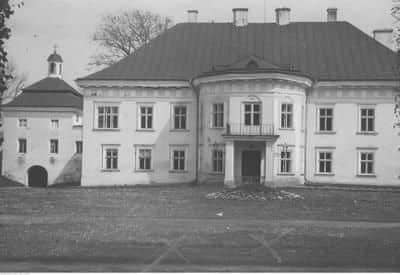The heritage of Yavorovo Krai through the pages of the past
There were many palaces, castles, and fortresses on the territory of the Yavoriv district. Fragments of some have survived to this day, but the mention of others, unfortunately, remains only in photographs. Therefore, today – a story about the ancient palace complex in Krysovychy, in Mostyshchyna.
Krysovychi, which begins just beyond the southern suburb of Mostysk – Zakostell, has been known since at least 1440. The name of the settlement comes from the ancient Russian noble family of the Krys. At the beginning of the 18th century the village was owned first by Stefan, and then by his son Michal Jan Zloczowsci of the coat of arms of Grabie. In the middle of the 18th century Krysovych went to the Mnishek family (actually Adam Józef Mnishek, 1721-1784). It was he who built the castle in Krysovychy. Together with the castle, the castle chapel was built, which was consecrated in 1780 by Lviv Archbishop Vaclav Serakovskii. A hundred years later, a palace was built next to the chapel. It follows from other sources that Adam Joseph chose Krysovychy as the place of his family residence – and on the site of the Zlochowski castle, he built a magnificent palace and surrounded it with a wonderful park. After his death, all the estates went to his son, 10-year-old Stanislav Mnishek (1774-1846), future husband of Helena Lubomyrska and ambassador to the Galician Diet. Stanislav and Helena’s son Adam (died in 1844) had no descendants, so the Krysovychs went to Ludgardza’s daughter (Ludgardza, 1823-1911, from 1843 married to Count Edward Peter Stadnytskyi, 1817-1902). Thus, the Krysovychis became the property of the Stadnytsky family for a whole century. The last owner of the village was Edward Peter’s grandson, Count Stanislav Adam Stadnytskyi (December 7, 1878 – about 1950). Now it is almost impossible to establish exactly when and by whom the Krysovytsi Palace was built – it is not even known how often and how much it was rebuilt. Approximate – only approximate! – date – 1780. But the residence in Krysovychy caused surprise and delight – that’s for sure. The first mention of the estate is in 1786 in the “Geography of Halychyna” by EA Kuropatnytskyi.
The oldest images of the Krysovytsia Palace date back to the 1820s. Some of them seem to have been written from memory, because they have little in common with reality. Yes, the palace itself is correctly shown in Joseph Richter’s watercolor, but when it came to the right pavilion, the author was overcome by a wave of fantasy. And P. Piller’s lithograph (based on Antony Liange’s drawing) shows the building practically the same as it is in the 1939 photographs. During the war, Russian troops damaged the palace, but the chapel remained intact. The palace was burned down in 1939, and in the 50s of the 20th century, its ruins were dismantled, and the premises of the collective farm were built from the building material. Until the beginning of the Second World War, the castle chapel was looked after by the Redemptorist Fathers from the Church of St. Catherine of Mostyskiy. The chapel had a main altar with an image of Christ Crucified.
To this day, the chapel has preserved frescoes, the author of which is believed to be the famous Lviv artist Stanislav Stroynskyi. In Soviet times, a collective farm warehouse was set up inside the chapel. The shrine was returned to the Roman Catholic community in 1990. During the next 5 years, the chapel was restored and premises were added to it, turning it into a temple. The work on the restoration of the temple was carried out according to the project of the Lviv artist Valery Bortyakov. In October 1995, the rebuilt shrine was consecrated under the title of Our Lady of Fatima, and in October 1997 the church was declared the Sanctuary of Our Lady of Fatima.
Sources:
https://oldena.lpnu.ua/handle/ntb/35533
https://audiovis.nac.gov.pl/obraz/116733:1/
https://polona.pl/search/?query=krysowice&filters=public:1

